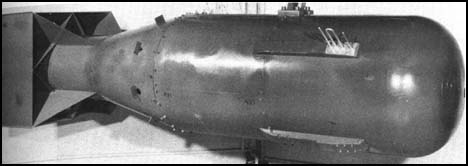Time Travel Research Center © 2005 Cetin BAL - GSM:+90 05366063183 - Turkey/Denizli
Nuclear Explosives
Nuclear explosives are the most powerful explosives except antimatter (discussed later). Nuclear weapons work by either fission or fission and fusion. Fission is the splitting of heavy nuclei and fusion is the joining of light nuclei. In fission, the heavy elements U235, a uranium isotope, and Pu239, plutonium are used. The center of a molecule is called the nucleus. It is made of protons and neutrons. When the nucleus of a U235 or Pu239 atom is hit by a free neutron it splits in a process called fission. This releases large amount of heat and energy. The core temperature is millions of degrees. The nucleus breaks into two smaller pieces and releases two or three free neutrons. These free neutrons run into other nuclei, creating a self-sustaining chain reaction. Dangerous radiation is also released.
Fusion is the opposite of fission, light atoms are joined. The elements usually used are the hydrogen isotopes tritium and deuterium. These combine to form helium and release energy. The reaction is thermonuclear (heat-induced). The more heat, the more atoms fuse; creating more energy. Because of the extremely high temperatures needed to initiate a thermonuclear reaction, a fission bomb is used as the trigger. Unlike fission, fusion does not produce radiation.
The power of nuclear weapons is measured in kilotons (kt) and megatons (mt). One kiloton is equivalent to one thousand tons of TNT. One megaton is equivalent to one million tons of TNT.
Nuclear Weapons: Types
There are two types of fission bombs; gun-type and implosion-type. Gun-type fission bombs work by forcing a smaller chunk of U235, called a plug, into a larger mass, called the target. About 40% of the fissile mass is in the plug. When the plug hits the target, the amount exceeds critical mass. This starts a uncontrolled chain reaction that makes the explosion.
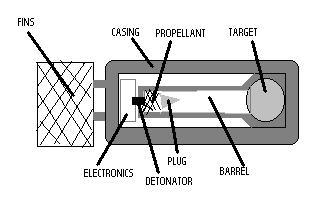
Implosion-type fission bombs work by compressing a hollow sphere of fissile material around a fissile core. There is already enough fissile material for critical mass, but it does not explode until compressed because it is not all together. To compress the U235 or Pu239 (which is more common) it is surrounded in a shell of high explosives. These explosives are called lenses and are carefully shaped and fitted together so even pressure is applied to the fission sphere. There are two types of high explosive lenses in the HE sphere. The U235 or Pu239 must be held together for a couple millionths of a second. This is done most effectively by using explosives of different speeds. This means that after the first explosive detonates and compresses the fission sphere, the second explosive goes off an instant later. This creates more pressure, holding it together longer so that the fission of the Pu239 is more efficient. The explosive lenses must be very hard so they don't lose shape over long periods of storage. While many different mixtures are used, the first fast lenses were made of TNT, RDX, and wax. The slow lenses were made with TNT, nitrocellulose, barium nitrate, and aluminum powder.
Implosion-type bombs are much more efficient than gun-type bombs because they are compressed so more of the material fissions. They also use less fissile material. Four "Fat Man" implosion bombs could be made from the large amount of U235 in one "Little Boy" gun-type bomb.
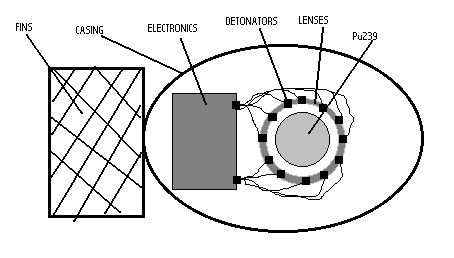
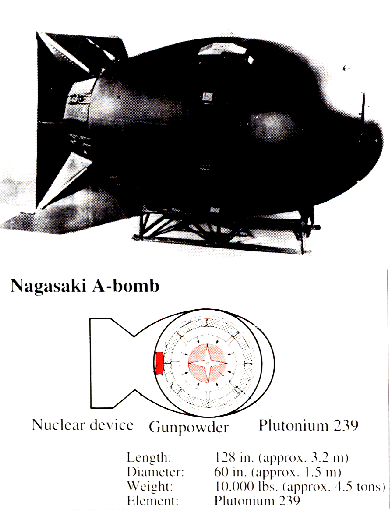 |
Nuclear Weapons: History
The idea that splitting heavy atoms could create energy came around the early 1900's. In 1903, a scientist named Ernest Rutherford discovered that many heavy elements like uranium, radium, and polonium spontaneously split, releasing radiation. While his partner Frederick Soddy, at their laboratory at the Mcgill University in Canada, was looking at uranium as a source of electrical energy, Rutherford was looking at its use in weapons. He said, "Could a proper detonator be found, it was just conceivable that a wave of atomic disintegration might be started through matter, which would indeed make this old world vanish in smoke." Scientists continued experiments on splitting atoms and did a lot of theoretical work. When WWII began on September 3, 1939, many scientists increased their efforts to discover how a nuclear bomb could be made. The American and British governments said research on the weapons should proceed with the highest priority.
The essential part of a nuclear bomb is achieving a self-sustaining chain reaction. This means that enough nuclei are splitting and releasing secondary neutrons that the reaction will continue by itself. The first self-sustaining occurred in an experiment on December 2, 1942. The test was called Chicago Pile 1 (CP-1)and proved it was possible that if U235 of good purity was used, it could be a powerful weapon. U235 is an isotope of natural uranium, U238. U238 does not normally fission and absorbs neutrons. The U238 must be separated from the U235 for the fission sphere or it will absorb too many neutrons. U235 is very rare and occurs in less than 1% of uranium. Plutonium was discovered after the CP-1 experiment. Pu239 does not occur naturally. It is formed when U238 absorbs an extra neutron.
The Manhattan Project was started in 1942 and headed by General Leslie Groves. The program was devoted to making nuclear weapons. The head scientist was Robert J. Oppenheimer. Other scientists who played a part in the program were Albert Einstein and Enrico Fermi.
Through the Manhattan Project, the gun-type and implosion-type bombs were developed. The first one designed was the gun-type It used U235. Pu239 would not work in a gun-type bomb because the pieces could not be fired together fast enough to efficiently fission. To solve this problem, the implosion-type bomb was made to use Pu239. The implosion-type was much more complicated than the gun-type; so a full-scale test was done. The gun-type was not tested for two reasons. It was simpler and they did not have enough U235 to make a second bomb.
The Trinity Test at Alamogordo, New Mexico occurred on July 16, 1945. The bomb was on the top of a 100' tower and weighed about 9,000 pounds. The bomb, called "Gadget," exploded with a yield (the power of the explosion) somewhere between 18kt and 23kt. This was much more powerful than the 8kt to 10kt predicted yield.
On August 1, 1945, the Enola Gay, a B-29 bomber, dropped "Little Boy" on the Japanese city of Hiroshima. It was the first nuclear weapon used in war and the first ever gun-type bomb used. The bomb exploded at an altitude of about 1900' and had a yield of about 15kt. About 70,000 people died within 24 hours.
When Japan did not surrender, a second bomb was used. The bomb was an implosion-type named "Fat Man." It was carried by "Bock's Car," a B-29 bomber. The initial target was Kokura, but heavy clouds, enemy fighters and anti-aircraft fire forced them away. The plane was running low on fuel and the only other target in range was Nagasaki. Because they were very low on fuel, only one pass could be made. The bomb hit several miles from the intended target. It exploded at an altitude of about 1650' with a yield of about 21kt. About 40, 000 were killed initially, but nobody really knows the eventual death toll from either bomb.
In 1942, Oppenheimer's theoretical study group was primarily focused on fission bombs, but fusion was also considered. In 1946, Edward Teller suggested that lithium-6 could be used as a fusion fuel to boost the power of fission weapons. Work was still concentrated on fission, so progress on fusion weapons was slow. On January 31, 1950, President Truman announced that the US should start focusing on the development of fusion bombs. From there, development increased greatly.
The first fusion bomb test was "Ivy Mike," on November 1, 1952. The bomb had a yield of 10.4mt, by far the most powerful explosion up to that time. It was the first bomb to use the Teller-Ulam staged design. The design uses a large fission bomb at one end and a tank of fission fuel at the other end. Between these were a plutonium rod called a spark plug. The fusion fuel was liquid deuterium and was surrounded by a large U238 tamper. The tamper absorbed neutrons and added to the bomb's power from a process called fast fission. While U238 will not ordinarily fission, if it is hit by high speed neutrons released from fusion, it can fission. The first stage of Ivy Mike, a TX-5 fission bomb, had a yield of 50kt. The deuterium fusion produced 2.4mt of the yield. The 465 kg U238 tamper was the largest contributor to the large yield, it produced 7.9mt as a result of fast fission by fusion neutrons. The diagram below shows the Teller-Ulam configuration.
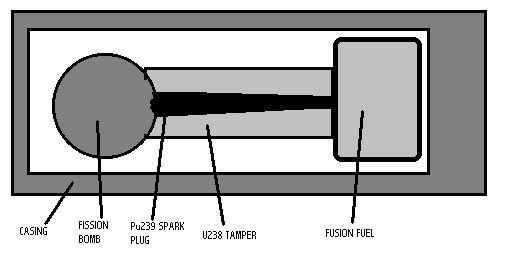
A later test named "Bravo" had a yield of 15mt, the largest US test. The largest nuclear test in history was on October 31, 1961, by the USSR. It was tested in Siberia and had a yield of 58mt.
Nuclear Weapons: Delivery Systems
For any weapon to be practical, it needs a way to get to the target reliably. Driving up to the target with a bomb on the truck is not usually an option. The first method of deliver for nuclear weapons was dropping unguided bombs from planes. The first bombs such as Little Boy were just like regular HE bombs with a different explosive. Newer bombs have parachutes for more getaway time, although air-dropped nuclear bombs are not very common.
Glide Bomb Units (GBU's) have wings and can glide up to 5 miles to a target. Another way to get longer range from a plane-dropped bomb is to use a method called a toss delivery. This is where gravity bombs are released from a plane while near the peak of a steep climb or while upside down and diving. With this technique, a standard gravity bomb travels in a arc and can travel about two miles to the target. Until GBU's and improved missiles were available, this was the best delivery system.
The next advancement came with the development of missiles with large payload capability. Early nuclear weapons were very heavy. Little Boy weighed 10,300 pounds. The first missiles were still launched from planes, but had much longer range. For example, the Blue Steel missile made in the 60's had a range of 220 miles.
Missiles are the most common delivery system for nuclear warheads. They can be launched from planes, mobile trucks, submarines, boats, silos, trains, anti-ship or aircraft missiles, tiny warheads that can be launched from bazooka type weapons, and even from space.
Mobile trucks and trains have the advantage of moving easily. A mobile target in much more difficult to locate, track, and attack than a stationary one.
Silo launched missiles are for hitting targets very far away. The missiles are called Intercontinental Ballistic Missiles (ICBM's) The longest range ICBM's can hit targets anywhere in the world. The advantage of these is they can be any size. This means they can carry more fuel and larger or more warheads. The more advanced missiles are MIRV capable. MIRV stands for Multiple Independently targeted Reentry Vehicle. MIRV capable missiles can hold up to ten separate warheads. Ballistic missile submarines nicknamed "boomers" also carry ICBM's.
Boats and smaller attack submarines can carry nuclear weapons in cruise missiles such as the subsonic Tomahawk. Larger boats can carry longer range supersonic missiles.
Anti-ship and anti-aircraft missiles can carry nuclear payloads. AS missile can be launched from shore emplacements, boats, planes, or submarines. Although uncommon, there are also nuclear torpedoes. Nuclear AS missiles and torpedoes are primarily for use against aircraft carriers that can withstand many hits before being destroyed. AA missiles are launched either from ground sites or planes. They are for destroying large enemy plane formations.
The smallest nuclear weapons, such as the MK-54, are so small they can be carried by a single person and fired from a portable launcher. The MK-54 weighs about 50 pounds, is the size of a basketball, and has a yield of 10 to 20 tons (not kilotons). They are not very common because of their short range and low power.
The newest delivery system is from space. While arming orbiting satellites violates the Space Armament Treaty, there is one system that sneaks around the treaty. The Fractional Orbit Bombardment System (FOBS) is similar to a satellite. It is launched from a normal satellite launch system and gets by the space weapons treaty because it does not make a complete orbit. Once in the right spot in orbit, retrorockets steer it so that it de-orbits and hits its ground target before making a full orbit. The reentry vehicles travel at extremely high speeds making them very difficult to intercept.
Nuclear artillery is another delivery system that is not commonly used. They do not have enough range to be very practical. The first nuclear artillery shell was a 15kt shell with a diameter of 280mm. Most artillery fired nuke warheads are between 10kt and 30kt.
Nuclear depth charges, while uncommon, could be very effective against submarine. Submarine hunting can take hours if it is found at all. The advantage of nuclear depth charges is that it does not need to be close to the sub to destroy it. This would save a lot of very important time, especially when facing multiple nuclear armed subs.
Antimatter
Antimatter is the opposite of matter. It is made of antiparticles; anti-electrons (also called positrons), anti-protons, and anti-neutrons. They have electrical charges opposite to their corresponding matter. Anti-electrons have a positive charge and anti-protons have a negative charge. The magnetic movement of antimatter is also opposite.
When antimatter meets normal matter, both are annihilated. It releases more energy than any other known kind of reaction. One kilogram of antimatter would have the power of 22,500,000 megatons. This is 387,931 times more powerful than the largest nuclear bomb ever exploded (58mt).
Antimatter was first made in 1996 by a team of international scientists. Several molecules of anti-hydrogen were made. Because antimatter explodes on contact with normal matter, it lasted only 40 billionths of a second before it exploded.
Conclusion
Explosives are some of the most useful tools ever invented. While most people consider them only as weapons of destruction, they are extremely important to our current standard of living. Most people don't know how important mining and quarrying are and don't know how much explosives are relied upon for both. Without explosives, the efficiency of mines and quarries would be reduced to one one-hundredth of what they are at now. While explosives are somewhat dangerous, so is life, and the benefits far outweigh the risks.
Hiçbir yazı/ resim izinsiz olarak kullanılamaz!! Telif hakları uyarınca bu bir suçtur..! Tüm hakları Çetin BAL' a aittir. Kaynak gösterilmek şartıyla siteden alıntı yapılabilir.
The Time Machine Project © 2005 Cetin BAL - GSM:+90 05366063183 -Turkiye/Denizli
Ana Sayfa /index /Roket bilimi /![]() E-Mail /CetinBAL/Quantum Teleportation-2
E-Mail /CetinBAL/Quantum Teleportation-2
Time Travel Technology /Ziyaretçi Defteri /UFO Technology/Duyuru
